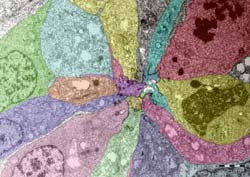

Named after its position on the flanks of adult fish, the lateral line is a series of sensory organs through which most fish detect vibrations in the water, helping them to detect predators or prey, for example. As a zebrafish embryo develops, the cells that will form its lateral line have to become pointed at one end and arrange themselves around a central, unchanged cell, like cloves in a bulb of garlic, forming a rosette. This microscopy image shows one such rosette, magnified approximately 1000 times.
The EMBL scientists discovered that if the cells can’t change shape to form rosettes, they don’t migrate properly along the embryo’s sides, and the lateral line doesn’t develop. “Surprisingly, we also found that this change in cell shape is triggered by a molecular signal that’s known to have the opposite effect in other situations,” Gilmour says: “activating this same signal in a developing chick, for instance, leads to a completely different picture.”
Policy regarding use
EMBL press and picture releases including photographs, graphics, movies and videos are copyrighted by EMBL. They may be freely reprinted and distributed for non-commercial use via print, broadcast and electronic media, provided that proper attribution to authors, photographers and designers is made.
Sonia Furtado
EMBL Press Officer
Meyerhofstr. 1, 69117 Heidelberg, Germany
Tel.: +49 (0)6221 387 8263
Fax: +49 (0)6221 387 8525
sonia.furtado@embl.de












